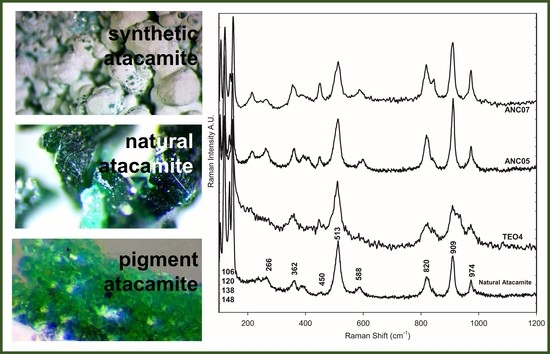Methodologies for the Characterization and Identification of Natural Atacamite as a Pigment in Andean Colonial Painting
Abstract
1. Introduction
1.1. Atacamite as a Pigment in Andean Colonial Art
1.2. Atacamite as a Natural or Synthetic Mineral
2. Experimental
2.1. Samples and References
2.1.1. Altarpiece Painting Samples
2.1.2. Mineral Reference Samples
2.1.3. Synthetic References: Greproduction of Old Recipes
2.2. Instrumental, Samples, and References
2.2.1. Microscopy and Microanalysis
2.2.2. Portable X-ray Fluorescence Spectroscopy
2.2.3. Infrared Spectroscopy
2.2.4. Micro-Raman Spectroscopy
2.2.5. Wide-Angle X-ray Scattering (WAXS)
3. Results and Discussion
3.1. Altarpiece Samples
3.1.1. Manufacturing Technique and Ground Layer
3.1.2. Green Samples
3.1.3. Other Colour Samples
3.2. Mineral Samples of Atacamite
3.3. Synthetic Copper Green Pigments Using Old Recipes
3.3.1. Viride salsum by Theophilus (TEO)
3.3.2. Cardenillo vermicular by Laguna (CV)
3.4. Global Comparative Analysis: Tools for Characterization Method Development
4. Conclusions
Supplementary Materials
Author Contributions
Funding
Data Availability Statement
Acknowledgments
Conflicts of Interest
References
- Tomasini, E.P.; Landa, C.R.; Siracusano, G.; Maier, M.S. Atacamite as a natural pigment in a South American colonial polychrome sculpture from the late XVI century. J. Raman Spectrosc. 2013, 44, 637–642. [Google Scholar] [CrossRef]
- Tomasini, E.P.; Marte, F.; Careaga, V.P.; Landa, C.R.; Siracusano, G.; Maier, M.S. Virtuous colours for Mary. Identification of lapis lazuli, smalt and cochineal in the Andean colonial image of Our Lady of Copacabana (Bolivia). Philos. Trans. R. Soc. A Math. Phys. Eng. Sci. 2016, 374, 20160047. [Google Scholar] [CrossRef]
- Tomasini, E.; Castellanos Rodríguez, D.; Gómez, B.A.; de Faria, D.L.A.; Landa, C.R.; Siracusano, G.; Maier, M.S. A multi-analytical investigation of the materials and painting technique of a wall painting from the church of Copacabana de Andamarca (Bolivia). Microchem. J. 2016, 128, 172–180. [Google Scholar] [CrossRef]
- Tomasini, E.; Costantini, I.; Rúa Landa, C.; Guzmán, F.; Pereira, M.; Castro, K.; Siracusano, G.; Madariaga, J.M.; Maier, M. Identification and characterization of basic copper sulfates as mineral green pigments in Andean colonial mural paintings: Use of temperature-controlled stage for the study of thermal induced antlerite degradation. J. Raman Spectrosc. 2021, 52, 2204–2217. [Google Scholar] [CrossRef]
- Siracusano, G. Pigments and Powers in the Andes: From the Material to the Symbolic in Andean Cultural Practices 1500–1800; Archetype Publications: London, UK, 2011. [Google Scholar]
- Siracusano, G.A. Mary’s Green Brilliance: The Case of the Virgin of Copacabana. J. Interdiscip. Hist. 2014, 45, 389–406. [Google Scholar] [CrossRef]
- Sepúlveda, M. Pinturas rupestres y tecnología del color en el extremo sur de Chile. Magallania 2011, 39, 193–210. [Google Scholar] [CrossRef]
- Sepúlveda, M.; Figueroa, V. Pigmentos y pinturas de mineral de cobre en la región de Tarapacá, norte de Chile: Nuevos datos para una tecnología pigmentaria prehispánica. Estud. Atacameños 2014, 48, 23–37. [Google Scholar] [CrossRef]
- Ramos Gavilán, A. Historia del Santuario de Nuestra Señora de Copacabana [1621]; Pastor, I.P., Ed.; Talleres Gráficos PL Villanueva: Lima, Peru, 1988. [Google Scholar]
- Siracusano, G.; Maier, M.; Tomasini, E.; Rua Landa, C. “If you want to be a painter, paint the mother monkey with her baby”. New Studies on the Image of Our Lady of Copacabana. In Materia Americana in the body of Spanish American Images from 16th to Mid 19th Centuries; Siracusano, G., Rodriguez Romero, A., Eds.; Eduntref: Saenz Peña, Argentina, 2020; pp. 385–398. [Google Scholar]
- Dodwell, C.R. Theophilus: De Diversis Artibus; Thomas Nelson & Sons: Oxford, UK, 1961. [Google Scholar]
- Scott, D.A. Copper and Bronze in Art: Corrosion, Colorants and Conservation; The Getty Conservation Institute: Los Angeles, CA, USA, 2002. [Google Scholar]
- Scott, D.A.; Taniguchi, Y. The verisimilitude of verdigris: A review of the copper carboxylates. Stud. Cons. 2001, 46, 73–91. [Google Scholar] [CrossRef]
- De Laguna, A. Pedacio Dioscórides Anazarbeo, Acerca de la Materia Médica Medicinal y de Los Venenos Mortíferos (S. I d. C), Trad. del Griego al Castellano y Comentarios de A. de Laguna (1566); Biblioteca de Clásicos de la Medicina y de la Farmacia Española: Madrid, Spain, 1999. [Google Scholar]
- Sandu, I.C.A.; Afonso, L.U.; Murta, E.; De Sa, M.H. Gilding techniques in religious art between East and West, 14th–18th centuries. Int. J. Conserv. Sci. 2010, 1, 28–31. [Google Scholar]
- Prieto-Taboada, N.; Larrañaga, A.; Gómez-Laserna, O.; Martínez-Arkarazo, A. Raman spectroscopy for the characterization of the CaSO4–H2O system compounds. Microchem. J. 2015, 122, 102–109. [Google Scholar] [CrossRef]
- de Faria, D.L.A.; Venâncio Silva, S.; de Oliveira, M.T. Raman microspectroscopy of some iron oxides and oxyhydroxides. J. Raman Spectrosc. 1997, 28, 873–878. [Google Scholar] [CrossRef]
- Brooker, M.H.; Sunder, S.; Taylor, P.; Lopata, V.J. Infrared and Raman spectra and X-ray diffraction studies of solid lead(II) carbonates. Can. J. Chem. 1983, 61, 494–502. [Google Scholar] [CrossRef]
- Martens, W.; Frost, R.L.; Williams, P.A. Raman and infrared spectroscopic study of the basic copper chloride minerals—Implications for the study of the copper and brass corrosion and ‘bronze disease’. Neues Jahrb. Fur Mineral. Abhandlungen. 2002, 178, 197–215. [Google Scholar] [CrossRef]
- Frost, R.L.; Martens, W.N.; Kloprogge, J.T.; Williams, P.A. Raman spectroscopy of the basic copper chloride minerals atacamite and paratacamite—Implications for the study of copper, brass and bronze objects of archeological significanc. J. Raman Spectrosc. 2002, 33, 801–806. [Google Scholar] [CrossRef]
- Frost, R. Raman spectroscopy of selected copper minerals of significance in corrosion. Spectrochim. Acta A 2003, 59, 1195–1204. [Google Scholar] [CrossRef] [PubMed]
- Tomasini, E.; Cárcamo, J.; Castellanos Rodríguez, D.M.; Careaga, V.; Gutiérrez, S.; Rúa Landa, C.; Sepúlveda, M.; Guzman, F.; Pereira, M.; Siracusano, G.; et al. Characterization of pigments and binders in a mural painting from the Andean church of San Andrés de Pachama (northernmost of Chile). Herit. Sci. 2018, 6, 1–12. [Google Scholar] [CrossRef]
- Tomasini, E.; Costantini, I.; Careaga, V.; Rua Landa, C.; Castro, K.; Madariaga, J.M.; Maier, M.S.; Siracusano, G. Identification of pigments in a 17th century mural painting (Bolivia) using spectroscopic techniques with imaging methods. J. Cult. Herit. 2023. submitted. [Google Scholar] [CrossRef]
- Tomasini, E.P.; Halac, E.B.; Reinoso, M.; Di Liscia, E.J.; Maier, M.S. Micro-Raman spectroscopy of carbon-based black pigments. J. Raman Spectrosc. 2012, 43, 1671–1675. [Google Scholar] [CrossRef]
- Burgio, L.; Clark, R.J.H.; Firth, S. Raman spectroscopy as a means for the identification of plattnerite (PbO2), of lead pigments and of their degradation products. Analyst 2001, 126, 222–227. [Google Scholar] [CrossRef]
- Bell, I.M.; Clark, R.J.H.; Gibbs, P.J. Raman spectroscopic library of natural and synthetic pigments (pre-∼ 1850 AD), Spectrochim. Acta-Part A Mol. Biomol. Spectrosc. 1997, 53, 2159–2179. [Google Scholar] [CrossRef]
- Seldes, A.M.; Burucúa, J.E.; Maier, M.S.; Gonzalo, A.; Jáuregui, A.; Siracusano, G. Blue Pigments in South American Painting (1610-1780). J. Am. Inst. Conserv. 1999, 38, 100–123. [Google Scholar]
- de La Roja, J.M.; Baonza, V.G. Application of Raman microscopy to the characterization of different verdigris variants obtained using recipes from old treatises. Spectrochim. Acta A 2017, 68, 1120–1125. [Google Scholar] [CrossRef]
- Buse, J.; Otero, V. New Insights into Synthetic Copper Greens: The Search for Specific Signatures by Raman and Infrared Spectroscopy for Their Characterization in Medieval Artworks. Herit. Sci. 2019, 2, 1614–1629. [Google Scholar] [CrossRef]
- Aguirre, J.M.; Adamo, G.; Giraldo, O. Simple Route for the Synthesis of Copper Hydroxy Salts. J. Braz. Chem. Soc. 2011, 22, 546–551. [Google Scholar] [CrossRef]
- Yoder, C.H.; Bushong, E.; Liu, X.; Weidner, V.; McWilliams, P.; Martin, K.; Lorgunpai, J.; Haller, J.; Schaeffer, R.W. The synthesis and solubility of the copper hydroxyl nitrates: Gerhardtite, rouaite and likasite. Mineral. Mag. 2010, 74, 433–440. [Google Scholar] [CrossRef]
- Pollard, A.M.; Thomas, R.G.; Willams, P.A. The stabilities of antlefite and Cu3SO4(OH)4.2H2O: Their formation and relationships to other copper (II)sulfate minerals. Mineral. Mag. 1992, 56, 359–365. [Google Scholar] [CrossRef]
- Scott, D.A. A Review of Copper Chlorides and Related Salts in Bronze Corrosion and as Painting Pigments. Stud. Conserv. 2000, 45, 39–53. [Google Scholar] [CrossRef]
- Yong, L. Copper trihydroxychlorides as pigments in China. Stud. Conserv. 2012, 57, 106–111. [Google Scholar] [CrossRef]
- Coccato, A.; Moens, L. On the stability of mediaeval inorganic pigments: A literature review of the effect of climate, material selection, biological activity, analysis and conservation treatments. Herit. Sci. 2017, 5, 1–25. [Google Scholar] [CrossRef]
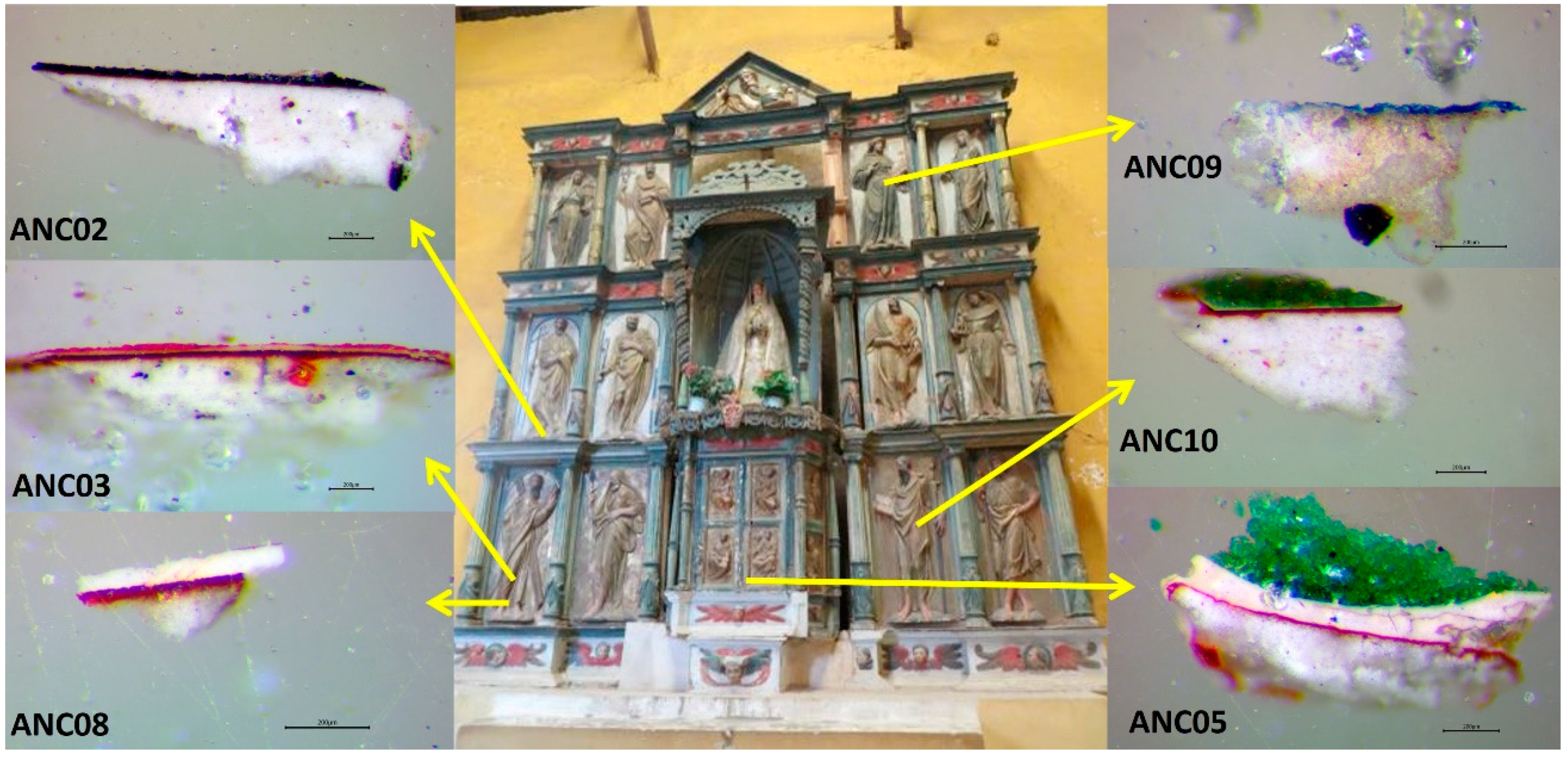
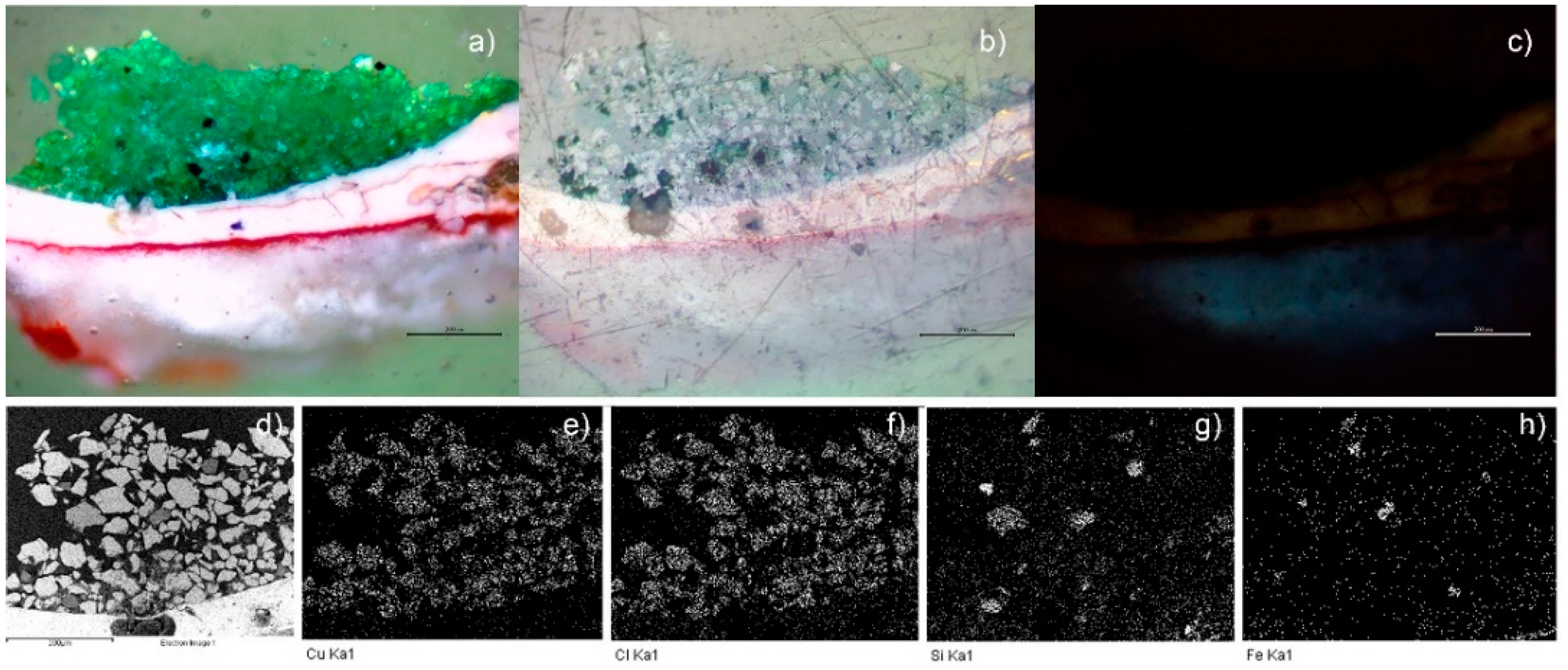
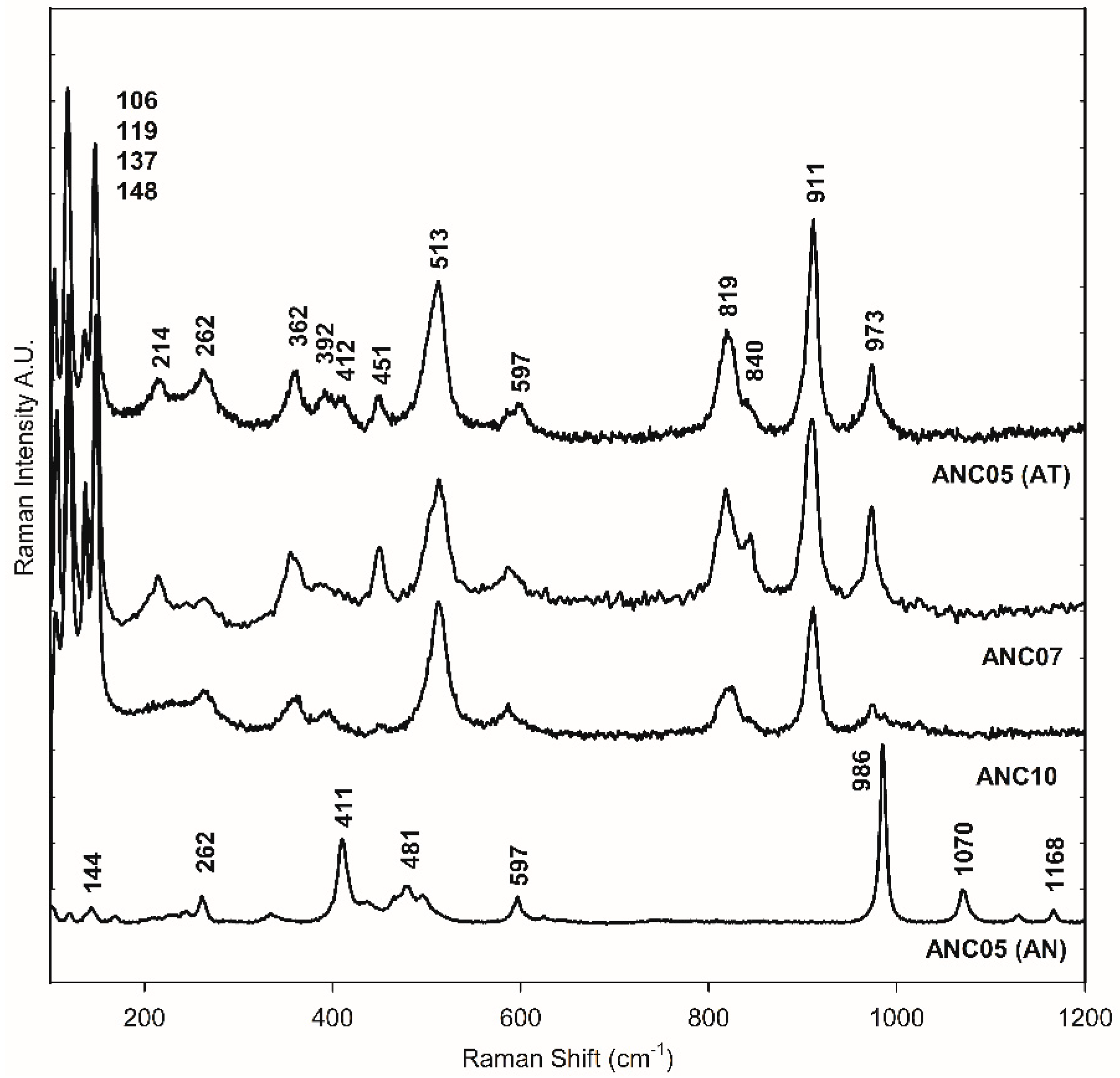

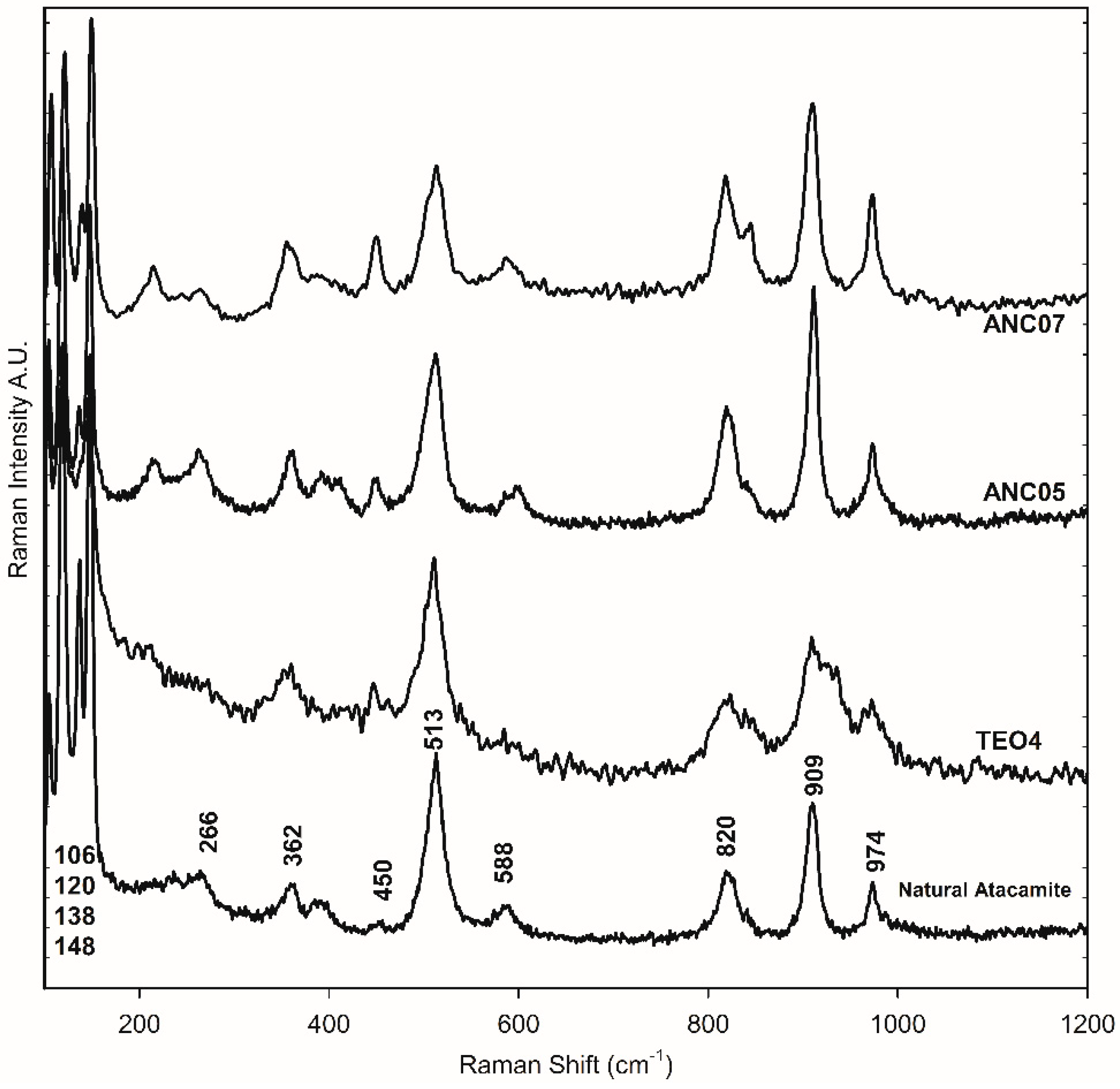
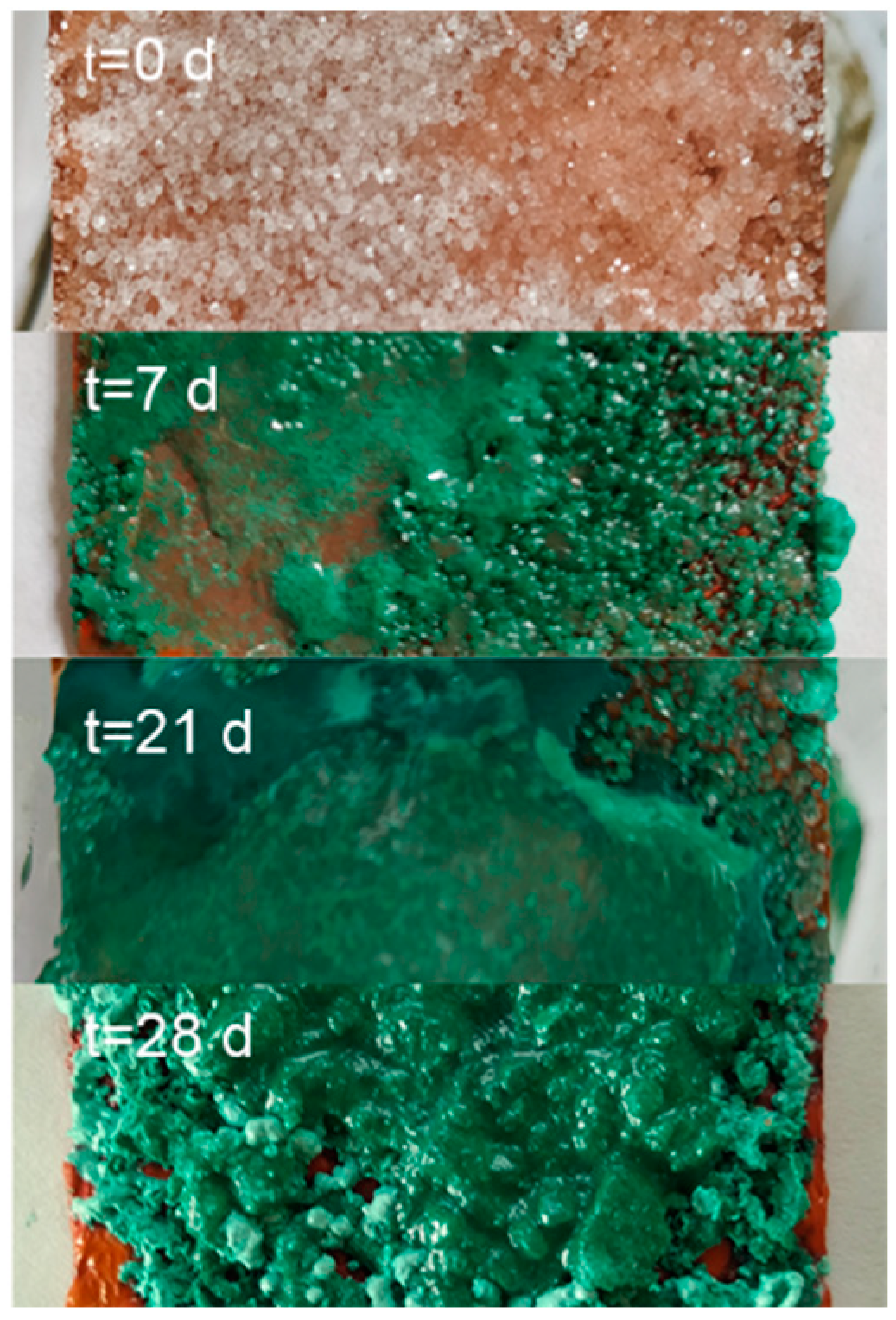


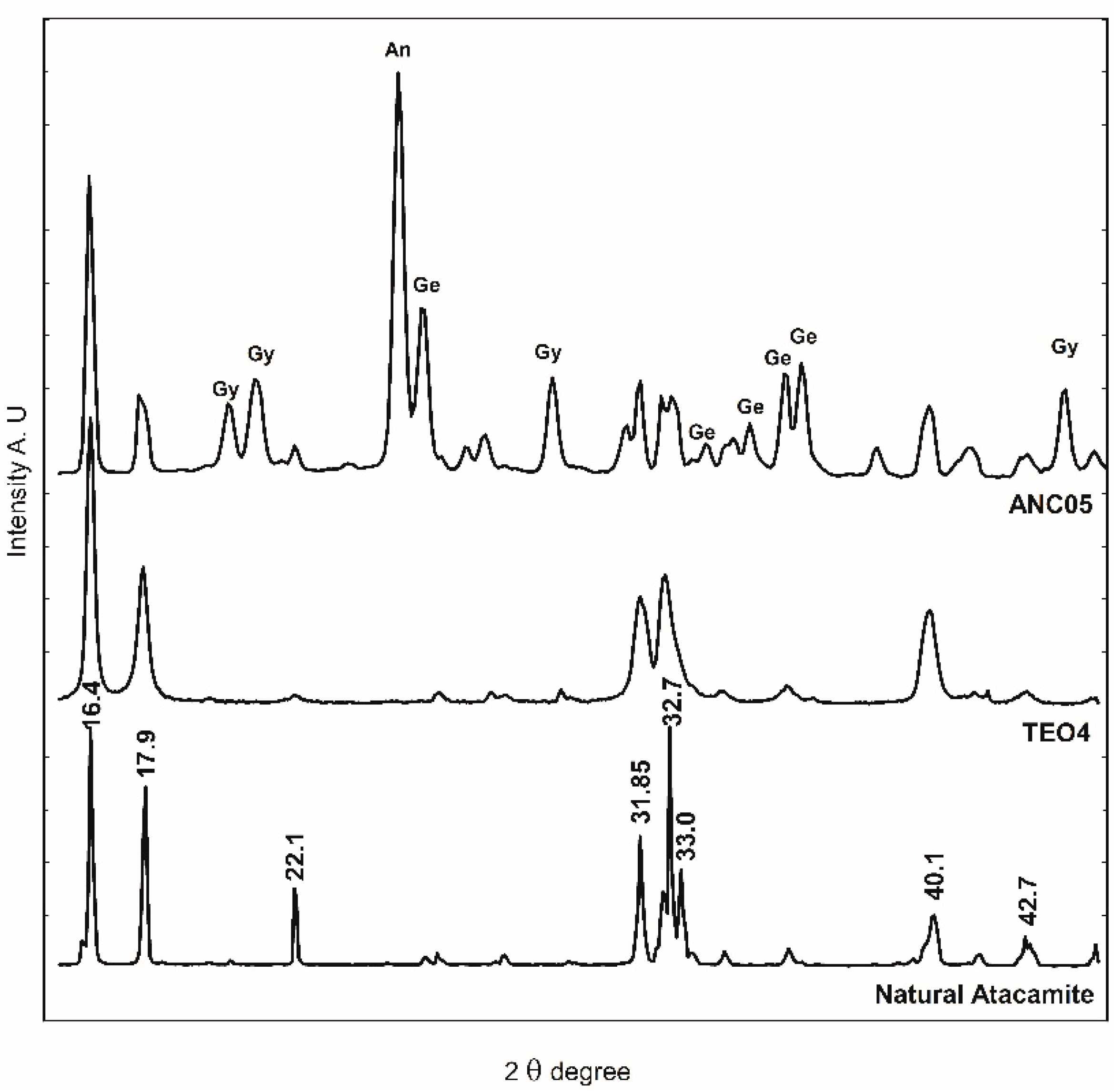
| Sample | Colour | Location |
|---|---|---|
| ANC02 | Blue-black and gilded | Board base |
| ANC03 | Red | Niche frame (hornacina) |
| ANC05 | Green | Saint’s cloak fold |
| ANC07 | Green | Tunic |
| ANC08 | White | Saint’s cloak |
| ANC09 | Blue | Franciscan saint’s tunic sleeve |
| ANC10 | Green | St. Paul’s tunic |
Disclaimer/Publisher’s Note: The statements, opinions and data contained in all publications are solely those of the individual author(s) and contributor(s) and not of MDPI and/or the editor(s). MDPI and/or the editor(s) disclaim responsibility for any injury to people or property resulting from any ideas, methods, instructions or products referred to in the content. |
© 2023 by the authors. Licensee MDPI, Basel, Switzerland. This article is an open access article distributed under the terms and conditions of the Creative Commons Attribution (CC BY) license (https://creativecommons.org/licenses/by/4.0/).
Share and Cite
De Haro, A.; Córdova, M.; Rua Landa, C.; Huck-Iriart, C.; Siracusano, G.; Maier, M.S.; Tomasini, E. Methodologies for the Characterization and Identification of Natural Atacamite as a Pigment in Andean Colonial Painting. Heritage 2023, 6, 5116-5129. https://doi.org/10.3390/heritage6070272
De Haro A, Córdova M, Rua Landa C, Huck-Iriart C, Siracusano G, Maier MS, Tomasini E. Methodologies for the Characterization and Identification of Natural Atacamite as a Pigment in Andean Colonial Painting. Heritage. 2023; 6(7):5116-5129. https://doi.org/10.3390/heritage6070272
Chicago/Turabian StyleDe Haro, Andrea, Milagros Córdova, Carlos Rua Landa, Cristián Huck-Iriart, Gabriela Siracusano, Marta S. Maier, and Eugenia Tomasini. 2023. "Methodologies for the Characterization and Identification of Natural Atacamite as a Pigment in Andean Colonial Painting" Heritage 6, no. 7: 5116-5129. https://doi.org/10.3390/heritage6070272
APA StyleDe Haro, A., Córdova, M., Rua Landa, C., Huck-Iriart, C., Siracusano, G., Maier, M. S., & Tomasini, E. (2023). Methodologies for the Characterization and Identification of Natural Atacamite as a Pigment in Andean Colonial Painting. Heritage, 6(7), 5116-5129. https://doi.org/10.3390/heritage6070272






